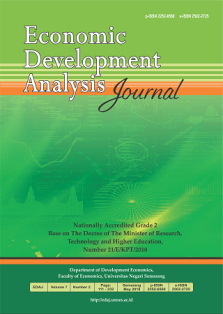Analysis of Bank Saving Growth Below IDR2 Billion in Indonesia
Abstract
The COVID-19 pandemic, global economic shocks, and global geopolitical risks have resulted in the banking industry facing global uncertainty that affects both banks and customers. This uncertainty has grown significantly in recent years. This research examines the differences between the periods before and after the COVID-19 pandemic and the long-term and short-term effects of inflation, BI-7DRR, deposit rates, SBN yields, and the COVID-19 pandemic on DPK growth. The research utilizes the Difference Test and the Error Correction Model methodologies. The study reveals differences in DPK, BI-7DRR, deposit rates, and SBN yields before and during the COVID-19 pandemic. The findings indicate that inflation, BI-7DRR, deposit rates, and the COVID-19 pandemic have a long-term impact but do not exhibit a short-term impact. Meanwhile, SBN yield has no long-term or short-term effect on DPK growth. Inflation affects the growth of DPK in the long term because people see the direction of economic conditions. BI-7DRR has a long-term with DPK because banks require a time lag. The level of DPK does change in the long term because banks must adjust interest rates based on economic conditions. Increased savings in banks because people see the COVID-19 pandemic as a shock economy. Disclaimer: All views in this paper are the authors' and do not necessarily reflect the views of Indonesia Deposit Insurance Corporation (Lembaga Penjamin Simpanan).


